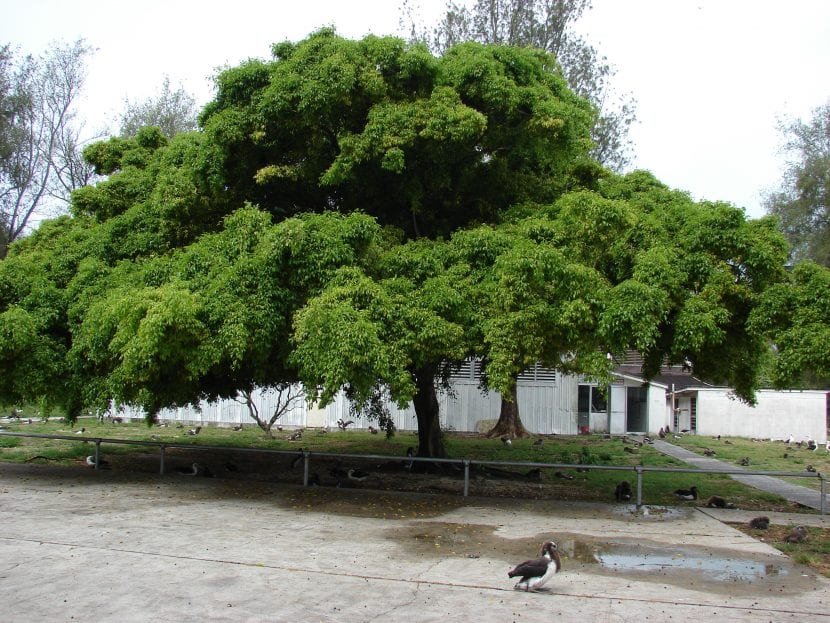
El Ficus benjamina It is one of the most cultivated trees: its crown is so extensive that the whole family can protect itself from the sun, its leaves are small enough so that it can be worked as Bonsai, and its maintenance is so simple that it adapts well to living in the home interior.
However, when before purchasing one we have to know a few things so that we can enjoy it to the fullest. Thus, we are going to tell you everything about him, Ficus benjamina.
Characteristics of Ficus benjamina
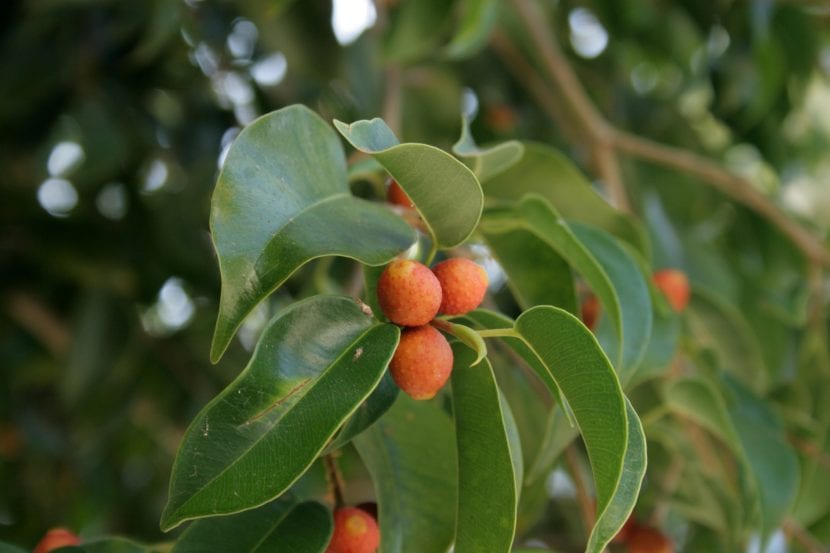
Our protagonist is a evergreen tree (that is, it remains evergreen) native to South and Southeast Asia, and South and North Australia. It is the official tree of Bangkok (Thailand). It is known by the names of boxwood or laurel of India, and is characterized by reaching a height of up to 15 meters, with a parasol glass of up to 6m. This is formed by leaves 6 to 13cm long, with an oval shape.
The fruit, the fig, is very small, barely 1cm. When they mature, they turn orange, which will be when the birds will eat them in their natural habitat.
How do you take care of yourself?
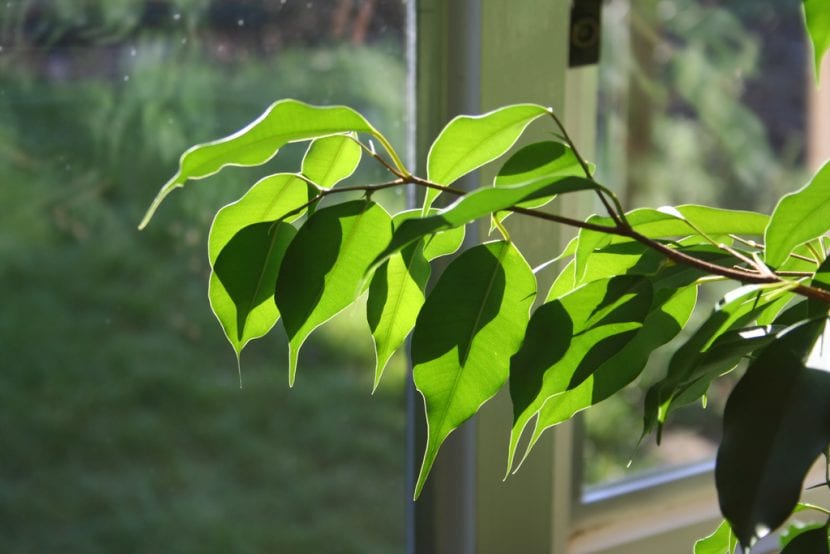
If you want to have a well-kept specimen, take into account our advice:
Location
Due to its adult size, it is best to be outside, in a large garden, in full sun. It should be planted at a minimum distance of 10 meters from soils, pipes and other tall plants, as it has an invasive root system.
It can, however, be in a very bright room in its youth, and even forever if it is pruned regularly.
Soil or substrate
Not demanding. It grows in any type of soil and substrate as long as it has good sewer system.
Irrigation
During the summer it has to be frequent, avoiding that the earth remains dry for a long time. The rest of the year you should water considerably less. As usual, you have to water about 3 times a week in the hottest months, and 1-2 / week the rest of the year.
Subscriber
If it is in the garden, fertilizing is not recommended, as its roots will already have the necessary nutrients; instead, if it is potted during spring and summer, it can be paid with universal liquid fertilizers following the instructions specified on the package.
Planting or transplanting time
Being a tropical tree, should be planted in the garden or moved to a larger pot in spring, when temperatures stay above 15 degrees Celsius.
Pests
Although it is a very resistant plant, especially indoors it can be attacked by:
- Red spider: They are red spider mites with a size of about 0,5 millimeters that adhere to the underside of the leaves, from where they will feed on the cells. The symptoms are the appearance of yellow spots that end up turning brown until dry. It is treated with acaricides.
- Mealybugs: they may have a cottony appearance or brown flakes that are located above all on the underside of the leaves. They can be removed with a cotton swab soaked in pharmacy alcohol.
- Aphid: they are very small parasites, about 0,5cm in length, which can be green, yellow or brown. They are found on the newer leaves, as well as on the tender stems. It is eliminated with insecticides with Chlorpyrifos.
Pruning
If required, can be pruned in late winter. Dry, diseased or weak branches and those that have grown too large must be removed with pruning shears previously disinfected with alcohol.
Multiplication
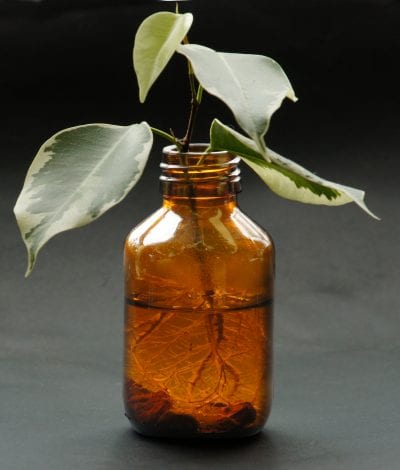
To get new copies, we can do two things: sow your seeds or make cuttings. Let us know how to proceed in each case:
Siembra
If we choose to sow its seeds, we can follow this simple step step:
- The first thing to do is acquire the seeds in spring and place them in a glass of water overnight. The next day, we will discard those that have been floating, since they will not serve us.
- Afterwards, we prepare the seedbed, which can be a flowerpot or a seedbed tray for example. We can also use milk containers or yogurt glasses, as long as we make a couple of holes for drainage.
- Once the seedbed has been chosen, we fill it almost completely with universal cultivation substrate, and we water.
- Then, we spread the seeds on its surface, leaving a distance between them of about 4cm.
- Now, we sprinkle a little sulfur or copper to prevent the proliferation of fungi.
- Finally, we cover them with a very thin layer of substrate, and we place the seedbed in an area where it gets direct sunlight.
If all goes well, they will germinate within 1 month.
Cuttings
If we want to make cuttings of Ficus benjamina We just have to choose a semi-woody branch of about 20cm in spring, place it in a container with water and dilute a few drops of liquid rooting hormones that we can find for sale in nurseries.
By changing the water daily and cleaning the container, it will root after 2-3 weeks.
Rusticity
Withstands frost up to -4ºC.
Ficus benjamina as Bonsai
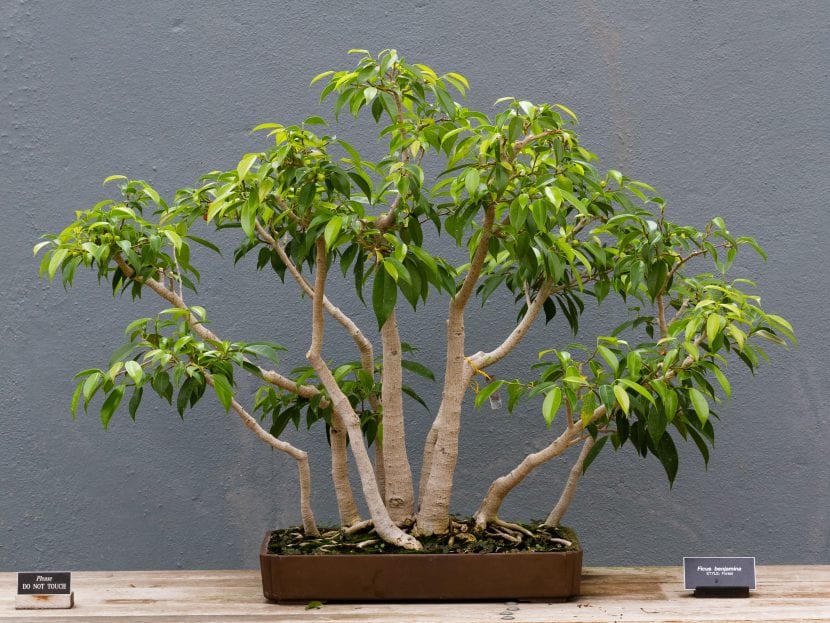
The Ficus, despite their invasive root system, are plants with which you can work very well, especially if they have relatively small leaves such as the f. benjamina. If we get one, the care we must provide is the following:
- Location: outside in semi-shade, or indoors with lots of light.
- Substratum: 60% mulch + 30% coarse sand + 10% black peat. Can also be used 100% akadama, or mix it with 30% kyriuzuna.
- Irrigation: prevent the substrate from drying out. During the summer it may be necessary to water 4-5 times a week; the rest of the year we will water every 2 or 3 days.
- Subscriber: with a fertilizer for bonsai following the indications specified on the package.
- Pruning: in spring, after transplanting. When the stem has 4-6 leaves, it will be cut leaving 2 leaves.
- Wiring: At any time of year. The trunk and branches should be protected with, for example, cotton, and checked from time to time.
- Transplant: every two years, in spring.
What did you think of the Ficus benjamina?
Hello, how are you? I have a ficus in the yard and a few months ago we can do it and from there it has not grown again, what can it be? What can you put on it to revive it? Thank you
Hi Roxana.
Do not worry. Water it from time to time, avoiding waterlogging, and it will surely not take long to sprout.
A greeting.
Hello, I just planted a Focus benjamina on the sidewalk outside my house, I don't know how recommendable it is
Hi July.
No, it is not recommended. The Ficus benjamina It is a tree that, as we explained in the article, needs room to grow. If you can, plant it at a distance of ten meters from the house and pipes so that no problems arise.
Regards!
Greetings Monica.
I have a Ficus Benjamina in a large pot in which the young leaves are folded (on themselves) and inside which you can see a kind of dark worms of about 2-3 mm. of length.
I would like to know what kind of plague is this and its possible solution.
Thank you very much in advance.
Greetings.
Hi Antoni.
Perhaps they are the larvae of a butterfly or moth. I recommend treating them with cypermethrin 10%.
A greeting.
Good morning Monica, I was given a ficus that has grown for a long time in a large pot and I took it to a house with a large plot of land, I have not planted it yet for fear that it will not grow, because the roots are seen as compacted inside that pot , is it likely that on land it will not develop after years of limiting space? if it develops, at what distance from my house should I bury it? Best regards and thank you very much!!
Hello Jorge.
Do not worry about it. Plant it without fear in the ground, yes, at a distance of at least 8m from pipes, walls, etc.
Greetings, and if you want, come by our Facebook group : )
Hello, I was offered a 200-meter plot, but at the entrance of the plot there are 3 very large and somewhat old ficus planted, I estimate that the crown of the three will have a length of at least 6 meters, which would be more or less a third of the land. I would like to know if building a house with those trees is a risk? Underground water is abundant in the area.
Thank you!
Hello Monica.
If you can build the house about ten meters from the tree trunks, you shouldn't have a problem. If not, action would have to be taken.
Regards!